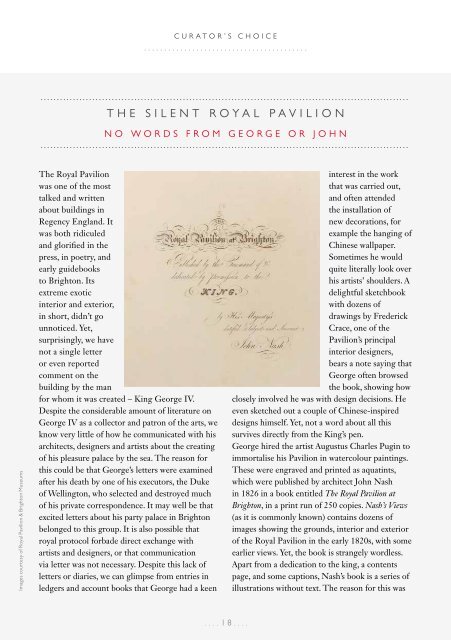Viva Brighton Issue #62 April 2018
Create successful ePaper yourself
Turn your PDF publications into a flip-book with our unique Google optimized e-Paper software.
CURATOR’S CHOICE<br />
.........................................<br />
THE SILENT ROYAL PAVILION<br />
NO WORDS FROM GEORGE OR JOHN<br />
Images courtesy of Royal Pavilion & <strong>Brighton</strong> Museums<br />
The Royal Pavilion<br />
was one of the most<br />
talked and written<br />
about buildings in<br />
Regency England. It<br />
was both ridiculed<br />
and glorified in the<br />
press, in poetry, and<br />
early guidebooks<br />
to <strong>Brighton</strong>. Its<br />
extreme exotic<br />
interior and exterior,<br />
in short, didn’t go<br />
unnoticed. Yet,<br />
surprisingly, we have<br />
not a single letter<br />
or even reported<br />
comment on the<br />
building by the man<br />
for whom it was created – King George IV.<br />
Despite the considerable amount of literature on<br />
George IV as a collector and patron of the arts, we<br />
know very little of how he communicated with his<br />
architects, designers and artists about the creating<br />
of his pleasure palace by the sea. The reason for<br />
this could be that George’s letters were examined<br />
after his death by one of his executors, the Duke<br />
of Wellington, who selected and destroyed much<br />
of his private correspondence. It may well be that<br />
excited letters about his party palace in <strong>Brighton</strong><br />
belonged to this group. It is also possible that<br />
royal protocol forbade direct exchange with<br />
artists and designers, or that communication<br />
via letter was not necessary. Despite this lack of<br />
letters or diaries, we can glimpse from entries in<br />
ledgers and account books that George had a keen<br />
interest in the work<br />
that was carried out,<br />
and often attended<br />
the installation of<br />
new decorations, for<br />
example the hanging of<br />
Chinese wallpaper.<br />
Sometimes he would<br />
quite literally look over<br />
his artists’ shoulders. A<br />
delightful sketchbook<br />
with dozens of<br />
drawings by Frederick<br />
Crace, one of the<br />
Pavilion’s principal<br />
interior designers,<br />
bears a note saying that<br />
George often browsed<br />
the book, showing how<br />
closely involved he was with design decisions. He<br />
even sketched out a couple of Chinese-inspired<br />
designs himself. Yet, not a word about all this<br />
survives directly from the King’s pen.<br />
George hired the artist Augustus Charles Pugin to<br />
immortalise his Pavilion in watercolour paintings.<br />
These were engraved and printed as aquatints,<br />
which were published by architect John Nash<br />
in 1826 in a book entitled The Royal Pavilion at<br />
<strong>Brighton</strong>, in a print run of 250 copies. Nash’s Views<br />
(as it is commonly known) contains dozens of<br />
images showing the grounds, interior and exterior<br />
of the Royal Pavilion in the early 1820s, with some<br />
earlier views. Yet, the book is strangely wordless.<br />
Apart from a dedication to the king, a contents<br />
page, and some captions, Nash’s book is a series of<br />
illustrations without text. The reason for this was<br />
....18....


















